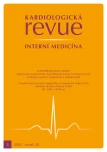Pheochromocytoma and the heart
Authors:
T. Zelinka
Authors‘ workplace:
Centrum pro diagnostiku a léčbu hypertenze, III. interní klinika – klinika endokrinologie a metabolismu 1. LF UK a VFN v Praze
Published in:
Kardiol Rev Int Med 2018, 20(3): 181-184
Overview
In pheochromocytoma, the secretion of catecholamines is accompanied with various clinical signs and symptoms such as hypertension, headache, palpitations and sweating. In some cases, the clinical course of pheochromocytoma may be disturbed by acute cardiovascular complications such as heart failure or cardiogenic shock, takotsubo cardiomyopathy, myocardial ischaemia, and arrhythmias – tachycardias (supraventricular or ventricular) or less frequently, bradycardias (AV blocks and junctional). As many of these complications are life-threatening, the most important part of the diagnosis is the awareness of pheochromocytoma as the cause of these clinical situations.
Key words:
pheochromocytoma – paraganglioma – hypertension – cardiomyopathy – arrhythmia
Sources
1. Zelinka T, Eisenhofer G, Pacak K. Pheochromocytoma as a catecholamine producing tumor: implications for clinical practice. Stress 2007; 10(2): 195– 203. doi: 10.1080/ 10253890701395896.
2. Crona J, Taïeb D, Pacak K. New perspectives on pheochromocytoma and paraganglioma: toward a molecular classification. Endocr Rev 2017; 38(6): 489– 515. doi: 10.1210/ er.2017-00062.
3. Opotowsky AR, Moko LE, Ginns J et al. Pheo-chromocytoma and paraganglioma in cyanotic congenital heart disease. J Clin Endocrinol Metab 2015; 100(4): 1325– 1334. doi: 10.1210/ jc.2014-3863.
4. McNeil AR, Blok BH, Koelmeyer T et al. Phaeochromocytomas discovered during coronial autopsies in Sydney, Melbourne and Auckland. Aust N Z J Med 2000; 30(6): 648– 652.
5. Paur H, Wright PT, Sikkel MB et al. High levels of circulating epinephrine trigger apical cardiodepression in a beta2-adrenergic receptor/ Gi-dependent manner: a new model of Takotsubo cardiomyopathy. Circulation 2012; 126(6): 697– 706. doi: 10.1161/ CIRCULATIONAHA.112.111591.
6. Ferreira VM, Marcelino M, Piechnik SK et al. Pheochromocytoma is characterized by catecholamine-mediated myocarditis, focal and diffuse myocardial fibrosis, and myocardial dysfunction. J Am Coll Cardiol 2016; 67(20): 2364– 2374. doi: 10.1016/ j.jacc.2016.03.543.
7. Zelinka T, Štrauch B, Pecen L et al. Diurnal blood pressure variation in pheochromocytoma, primary aldosteronism and Cushing's syndrome. J Hum Hypertens 2004; 18(2): 107– 111. doi: 10.1038/ sj.jhh.1001644.
8. Zelinka T, Štrauch B, Petrák O et al. Increased blood pressure variability in pheochromocytoma compared to essential hypertension patients. J Hypertens 2005; 23(11): 2033– 2039.
9. Messerli FH, Loughlin KR, Messerli AW et al. The president and the pheochromocytoma. Am J Cardiol 2007; 99(9): 1325– 1329. doi: 10.1016/ j.amjcard.2006.12.043.
10. Majtan B, Zelinka T, Rosa J et al. Long-term effect of adrenalectomy on cardiovascular remodeling in patients with pheochromocytoma. J Clin Endocrinol Metab 2017; 102(4): 1208– 1217. doi: 10.1210/ jc.2016-2422.
11. Lenders JW, Duh QY, Eisenhofer G et al. Pheochromocytoma and paraganglioma: an endocrine society clinical practice guideline. J Clin Endocrinol Metab 2014; 99(6): 1915– 1942. doi: 10.1210/ jc.2014-1498.
12. Agarwal G, Sadacharan D, Kapoor A, et al. Cardiovascular dysfunction and catecholamine cardiomyopathy in pheochromocytoma patients and their reversal following surgical cure: Results of a prospective case-control study. Surgery 2011; 150(6): 1202– 1211. doi: 10.1016/ j.surg.2011.09.001.
13. Ghadri JR, Wittstein IS, Prasad A et al. international expert consensus document on takotsubo syndrome (part i): clinical characteristics, diagnostic criteria, and pathophysiology. Eur Heart J 2018; 39(22): 2032– 2046. doi: 10.1093/ eurheartj/ ehy076.
14. Giavarini A, Chedid A, Bobrie G et al. Acute catecholamine cardiomyopathy in patients with phaeochromocytoma or functional paraganglioma. Heart 2013; 99(19): 1438– 1444. doi: 10.1136/ heartjnl-2013-304073.
15. Sauneuf B, Chudeau N, Champigneulle B et al. Pheochromocytoma crisis in the ICU: a french multicenter cohort study with emphasis on rescue extracorporeal membrane oxygenation. Crit Care Med 2017; 45(7): e657– e665. doi: 10.1097/ CCM.0000000000002333.
16. Agarwal V, Kant G, Hans N et al. Takotsubo-like cardiomyopathy in pheochromocytoma. Int J Cardiol 2011; 153(3): 241– 248. doi: 10.1016/ j.ijcard.2011.03.027.
17. Gorenek B, Boriani G, Dan GA et al. European Heart Rhythm Association (EHRA) position paper on arrhythmia management and device therapies in endocrine disorders, endorsed by Asia Pacific Heart Rhythm Society (APHRS) and Latin American Heart Rhythm Society (LAHRS). Europace 2018; 20(6): 895– 896. doi: 10.1093/ europace/ euy051.
18. Zelinka T, Petrák O, Turková H et al. High incidence of cardiovascular complications in pheochromocytoma. Horm Metab Res 2012; 44(5): 379– 384. doi: 10.1055/ s-0032-1306294.
19. Riester A, Weismann D, Quinkler M et al. Life-threatening events in patients with pheochromocytoma. Eur J Endocrinol 2015; 173(6): 757– 764. doi: 10.1530/ EJE-15-0483.
Labels
Paediatric cardiology Internal medicine Cardiac surgery CardiologyArticle was published in
Cardiology Review

2018 Issue 3
Most read in this issue
- Perindopril and cardiovascular disease – 25 years of success in cardiology
- Hypothyroidism and the heart
- Gestational diabetes mellitus and possibilities for its treatment
- Commented shortened version of the 2018 ESC Guidelines for the diagnosis and management of syncope
